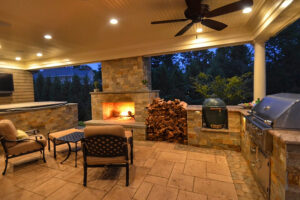Outdoor living spaces have become the ultimate extension of our homes, providing a sanctuary for relaxation, entertainment, and connection with nature. Whether you envision a sprawling backyard paradise or a cozy urban balcony, the process of transforming your outdoor area into a personalized haven requires thoughtful planning and strategic execution. In this comprehensive guide, we’ll navigate the key steps to designing your dream outdoor living space, empowering you to create a harmonious and functional extension of your home that reflects your unique style and lifestyle.
Step 1: Unleash Your Imagination
The first step in your outdoor living space journey is to unleash your imagination and dream big. Envision the endless possibilities that your outdoor canvas holds, free from any constraints or limitations. Sit back, close your eyes, and let your mind wander, conjuring up images of the perfect retreat. Do you envision a lush oasis with a cascading waterfall, a cozy gathering area around a crackling firepit, or a gourmet outdoor kitchen where you can entertain guests with culinary delights? Embrace your wildest ideas and jot them down, as these initial visions will serve as the foundation for your design.
Explore Inspirational Outdoor Spaces
Immerse yourself in the world of outdoor living by exploring inspirational spaces. Browse through design magazines, scroll through social media, or visit local home and garden shows to ignite your creativity. Pay attention to the elements that captivate you, such as the use of materials, the integration of water features, or the seamless transition between indoor and outdoor living. Collect visual references and make note of the design principles that resonate with your personal aesthetic.
Understand Your Lifestyle and Needs
As you dream up your ideal outdoor oasis, it’s crucial to consider how you and your family intend to utilize the space. Will it be a hub for lively gatherings, a serene retreat for relaxation, or a combination of both? Reflect on your everyday activities, hobbies, and entertainment preferences to ensure that your design caters to your unique lifestyle needs.
Step 2: Analyze Your Outdoor Canvas
With your visionary ideas in hand, it’s time to take a closer look at your existing outdoor space. Conduct a thorough assessment of the area, taking note of its dimensions, topography, sun exposure, and any existing structures or landscaping elements. This step is crucial in determining the feasibility of your design concepts and identifying any potential challenges or limitations.
Measure and Document Your Space
Accurate measurements are the foundation of a well-designed outdoor living area. Grab a tape measure and carefully document the dimensions of your space, including the length, width, and any changes in elevation. Be sure to note the location of any existing features, such as trees, sheds, or utility lines, as these will play a role in your layout and planning.
Evaluate Sun Exposure and Climate
The sun’s position and the prevailing weather conditions in your area will significantly impact the functionality and comfort of your outdoor living space. Observe how the sun moves across your yard throughout the day and note any areas that receive full sun, partial shade, or complete shade. This information will guide your decisions on the placement of shade structures, seating areas, and landscaping elements.
Identify Existing Strengths and Limitations
Take a critical look at your outdoor space and identify its inherent strengths and limitations. Perhaps you have a stunning view that you want to highlight, or a mature tree that provides natural shade. Conversely, you may need to address challenges such as a sloping terrain, a poorly positioned utility box, or an unsightly fence. Understanding these factors will help you develop a design that capitalizes on the positive aspects and mitigates the negative ones.
Step 3: Establish a Cohesive Design Aesthetic
With a clear understanding of your outdoor canvas, it’s time to translate your visionary ideas into a cohesive design aesthetic. This step involves selecting a unifying theme, color palette, and materials that will create a harmonious and visually appealing outdoor living space.
Define Your Desired Design Style
Reflect on the design styles that resonate with you, whether it’s a contemporary minimalist vibe, a rustic farmhouse charm, or a lush Mediterranean oasis. Research the key elements and materials associated with your preferred aesthetic, and use these as a guide to inform your design decisions.
Curate a Complementary Color Palette
The colors you choose for your outdoor living space will set the overall tone and mood. Opt for a palette that complements the existing architecture of your home and seamlessly integrates with the surrounding landscape. Consider using a mix of neutral tones, earthy hues, and pops of vibrant accents to create a visually striking and cohesive design.
Select Durable and Weather-Resistant Materials
When it comes to outdoor living, functionality and longevity are just as important as aesthetics. Carefully research and select materials that can withstand the elements, such as stone, brick, weather-resistant wood, or high-quality synthetic options. These materials will not only enhance the visual appeal of your space but also ensure it remains beautiful and functional for years to come.
Step 4: Define Your Outdoor “Rooms”
Just as your indoor living spaces are divided into distinct areas, your outdoor oasis should be thoughtfully zoned to create a sense of flow and purpose. By compartmentalizing your yard into various “rooms,” you can establish dedicated spaces for different activities and create a seamless, multifunctional outdoor living experience.
Identify Distinct Zones
Begin by envisioning the various ways you and your family will use the outdoor space. Will you need a dedicated dining area, a cozy lounge space, a play area for children, or a tranquil meditation nook? Sketch out these zones and consider how they will connect and complement one another, ensuring a harmonious overall design.
Utilize Landscaping Elements
Landscaping features, such as strategically placed trees, shrubs, and garden beds, can be powerful tools in defining and delineating your outdoor rooms. These natural elements can create visual boundaries, provide privacy, and enhance the overall ambiance of your space.
Incorporate Hardscaping Features
Hardscaping elements, like pathways, retaining walls, and raised planting beds, can also play a crucial role in establishing distinct areas within your outdoor living space. These structures can guide the flow of movement, create visual interest, and add depth and dimension to your design.
Step 5: Optimize Functionality and Comfort
Once you’ve established the overall layout and design aesthetic of your outdoor living space, it’s time to focus on the practical aspects that will ensure it’s both functional and comfortable for you and your guests.
Prioritize Seating and Dining Areas
Comfortable seating and dining areas are the heart of any outdoor living space. Carefully consider the size, arrangement, and materials of your patio furniture to create inviting and versatile gathering spots. Incorporate a mix of lounge seating, dining sets, and accent pieces to cater to a variety of activities.
Integrate Shading and Climate Control
Protecting your outdoor living space from the elements is crucial for year-round enjoyment. Incorporate shading solutions, such as umbrellas, pergolas, or retractable awnings, to provide relief from the sun. Additionally, consider incorporating heating or cooling elements, like outdoor fireplaces, fire pits, or strategically placed fans, to extend the usability of your space.
Enhance Ambiance with Lighting and Accessories
Thoughtful lighting and carefully curated accessories can transform your outdoor oasis into a truly enchanting space. Explore a variety of lighting options, from path lighting and spotlights to string lights and lanterns, to create a warm and inviting atmosphere. Complement your lighting with decorative elements, such as planters, sculptures, or outdoor artwork, to infuse your personal style and add visual interest.
Step 6: Incorporate Sustainable and Low-Maintenance Features
As you design your dream outdoor living space, consider incorporating sustainable and low-maintenance features that will not only benefit the environment but also reduce your long-term upkeep and expenses.
Prioritize Water-Wise Landscaping
Explore drought-tolerant and native plant species that thrive in your local climate, reducing the need for excessive watering and maintenance. Incorporate permeable hardscaping materials, like pavers or gravel, to allow for natural water absorption and minimize runoff.
Explore Renewable Energy Sources
Integrate renewable energy solutions, such as solar-powered lighting or outdoor appliances, to reduce your carbon footprint and lower your energy costs. These eco-friendly features can seamlessly blend into your design while contributing to a more sustainable outdoor living experience.
Streamline Maintenance with Smart Design
When planning your outdoor living space, consider low-maintenance design elements that will minimize your upkeep efforts. This may include the use of synthetic turf, self-cleaning water features, or automated irrigation systems that can be easily managed with your smartphone.
Step 7: Bring Your Vision to Life
With a comprehensive plan in place, it’s time to transform your outdoor living space from a dream into a tangible reality. Collaborate with experienced landscape designers, contractors, and tradespeople to ensure your vision is executed with precision and attention to detail.
Develop a Phased Implementation Plan
If your outdoor living project is too extensive to complete all at once, consider breaking it down into manageable phases. This will allow you to tackle the most pressing elements first, while leaving room for future expansions or refinements as your budget and timeline permit.
Oversee the Construction Process
Maintain an active role in the construction process, regularly communicating with your project team to ensure the work aligns with your design plan and specifications. Be prepared to make informed decisions on-site, as unexpected challenges may arise that require creative problem-solving.
Celebrate the Completion of Your Outdoor Oasis
Once your outdoor living space is fully realized, take the time to bask in the beauty and functionality of your creation. Gather your family and friends to inaugurate the space with a celebratory gathering, and embrace the endless possibilities for relaxation, entertainment, and connection that your new outdoor oasis provides.
Designing your dream outdoor living space is a transformative journey that requires careful planning, creative vision, and a deep understanding of your personal needs and lifestyle. By following the steps outlined in this comprehensive guide, you’ll be well on your way to creating a harmonious and functional extension of your home that seamlessly blends indoor and outdoor living.
Contact Us (513) 769-5044 for a Consultation!
About Business Concepts Remodeling

Building Concepts specializes in custom remodeling projects across the Greater Cincinnati Area. Our comprehensive residential and commercial experience has built a reliable reputation you can trust. Everyday we work to build trust through communication and attention to detail. We strive to enhance the lives of our clients by providing high quality solutions with hands on service. Throughout the remodeling project, minimal disruption to your home or office is our highest priority.
> Learn More



